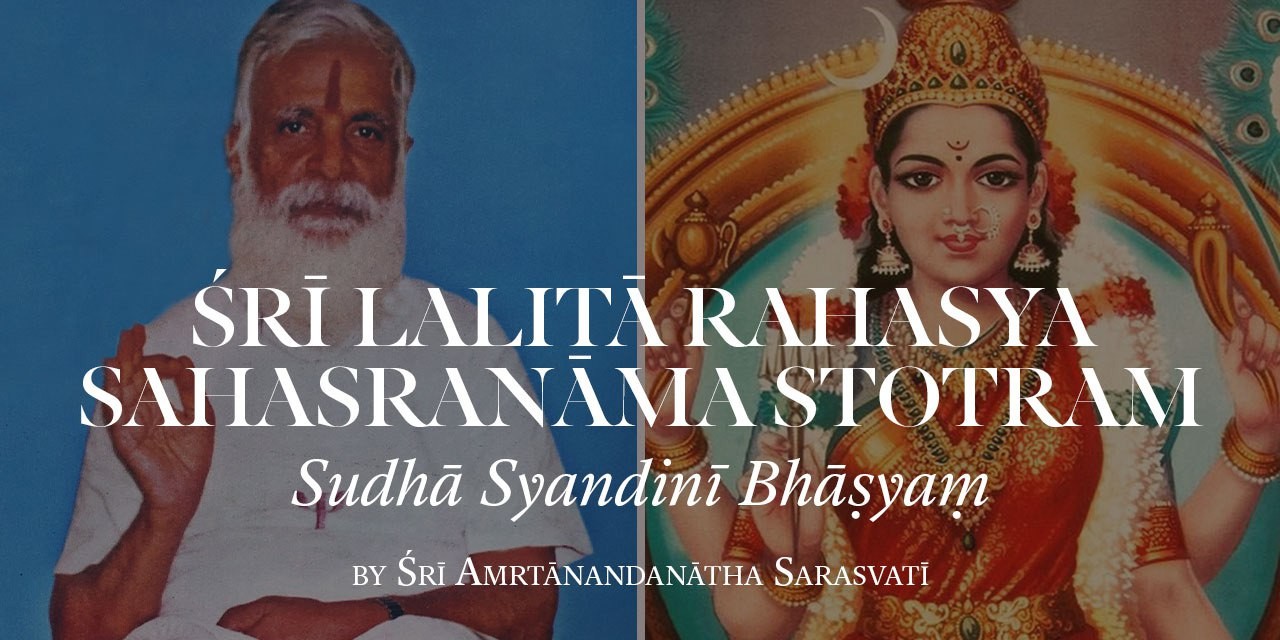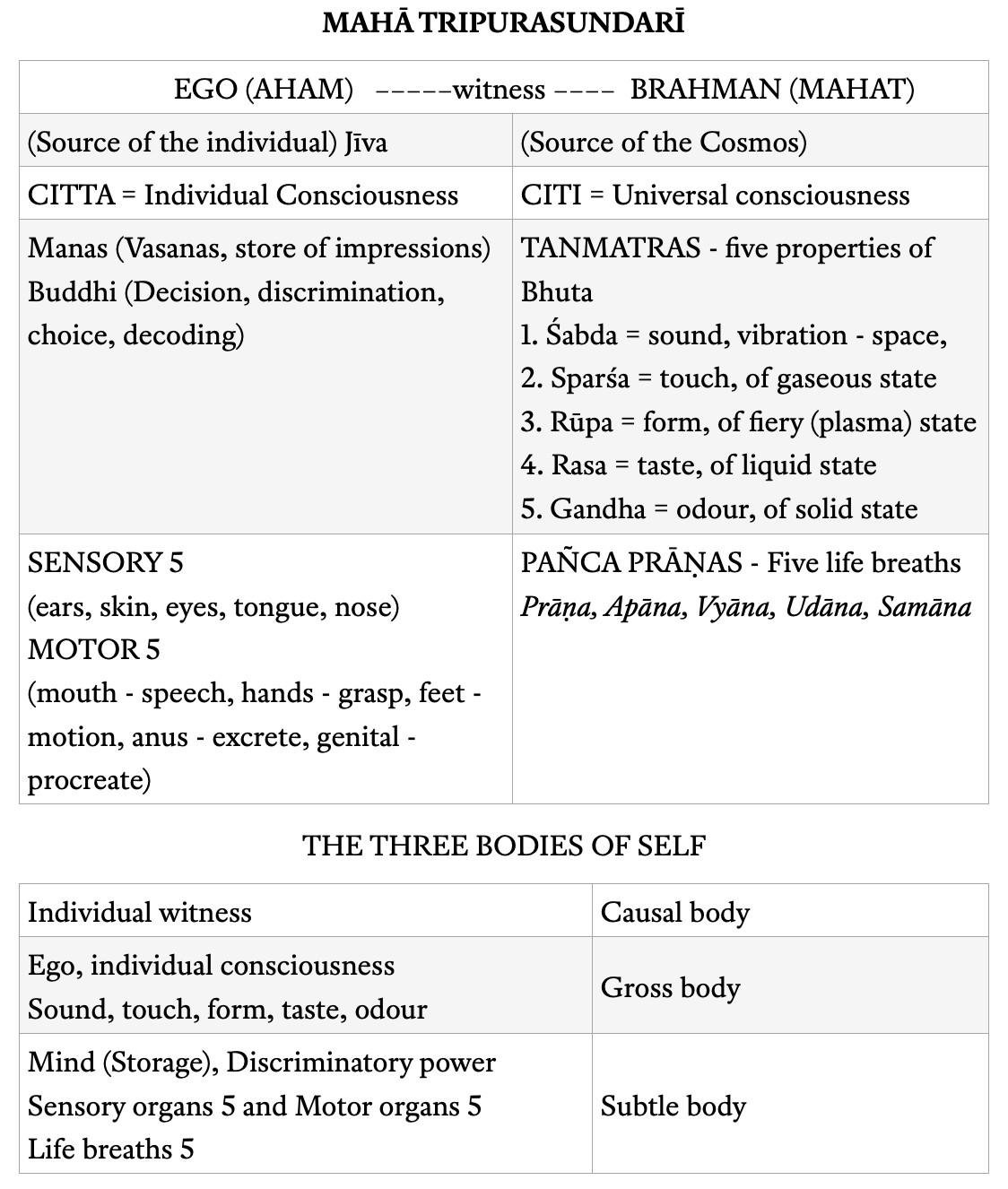
56) Śrīman-nagara-nāyikā
Leader of the city of prosperity.
What is prosperity? What is wealth? It has been defined in Śrī Sūkram that wealth is fire, breeze, sun, land, lightning, intelligence, water. It is clear that the vedic insights had arranged the sources of energy in some ancient order of priorities. It is interesting to note that only renewable and non-polluting sources of energy are mentioned.
The Śrī Cakra, or Śrī Nagara is a city of wealth and happiness, where the fires of sacrifice burn steadily, waters of happiness flow perennially like rivers, the sun of creativity shines coolly, and the lightening of enlightenment flashes constantly bringing rains to fertilise the lands of the binds of people inhabiting the city. It is a city of gardens, lakes, palaces full of enjoyments, all of which can be had for a mere wish, because wish fulfilling trees are to be found in every nook and corner of this city. Lalitā is the Empress of this city, naturally, because all aspects of such a city are built up of consciousness, just as this world of ours is also built of our consciousness. Consciousness, caitanya, is Lalitā. She is the Śṛṅgāranāyikā of Śrīnagara. A city built of good wishes, good thoughts, and happiness to everyone in unbounded measure; the more people contribute their consciousness towards realization of such a dream city the more it will come true in life, the more it will materialize. May the meditations of talented people enrich the lives of all people, so that many can take advantage of the efforts of the few.
Materialization, that is an important word. The function of any management is to have a precise dream and bring that dream to life. Śrī Cakra is such an archetype of a dream, which embodies many of such dreams. It is a dream of God himself to have a beautiful diversity without misery. God is slowly realizing that misery need not form a part of the contrast to make this world picture. There is enough contrast in happiness itself without misery to be able to construct a multi coloured and aesthetic picture. An invariant happiness, solidified pleasure, unhurried, leisurely pace of life, that seems to be the harmonious goal of God. God has realised that misery was a mistake and he is taking steps to remove it through the good thoughts of all sages.
Materialization proceeds through three stages. First, God wished that he be many. His power of willing separated from him. This power, called Icchaśakti or Tripurasundarī, the beautiful one of the three worlds then proceeds to create the worlds as follows. First, an individual ego separates from Herself the remainder being called mahat. See the picture. Mahat is the unmanifest womb of the cosmos whereas ego is the unmanifest womb of the individual who later on perceives the manifest world. The universal witness is God. The witness confined to an ego is called the jīva; such a jīva is called the causal body of the person.

////// MISING CONTENT //////
[continued]… couple to create the cosmos, its perceptions, the individual and its perceptions.

Beyond all these three bodies corresponding to the waking, dreaming, sleeping states lies the will power of God which has created the cosmos as well as the individual.
There are many possible enumerations of sequences for the possible schemes of evolution. But this is a reasonably simple scheme which can be understood by one and all. Therein lies its simplicity and beauty.
The Śrī Cakra is a geometrical structure of elegance, which is a pictorial symbol of these three bodies and the transcendental reality of Lalitā Mahā Tripurasundarī. It has nine enclosures covering these three bodies, three enclosures for each body.
The central point of the Śrī Cakra is the dimensionless entity beyond the space and time, the omnipotent in union with all his powers. Mahā Kāmeśvara, none other than the sadhāka himself, is in union with all his powers of the cosmos, all manifestations of the divine will power.
Each name of Lalitā Sahasranāma has meanings at all these three and the transcendental levels. We shall hereafter refer to as:
gross = g, subtle = s, causal = c, and transcendental = t.
These symbols coming at the beginning of a para indicate that that explanation relates to that level of the body.
Source: Śrī Amṛtānandanātha Saraswatī "Sudhā Syandinī Bhāṣyaṃ" Typed Manuscript
(an incomplete commentary on Lalitā Sahasranāma)
